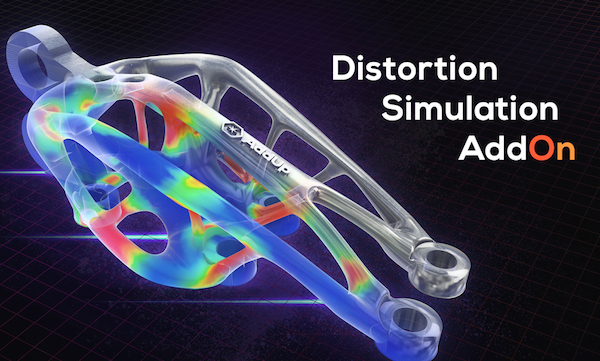ESI, AddUp Team on Distortion Simulation
New Distortion Simulation AddOn module will help mitigate distortion problems for metal additive manufacturing processes.

ESI Group and AddUp have created a distortion simulation module called AddOn to help reduce distortions in metal additive manufacturing processes. Image courtesy of ESI Group.
Latest News
May 22, 2019
In metal additive applications, distortion can be a significant problem. As parts are produced, the melting and cooling of the material can result in warping and flaws that render the final product unusable.
Simulation can help minimize or eliminate the effect of these distortions, allowing companies to make adjustments to the production process in advance to minimize waste and improve print results. ESI Group has teamed with additive manufacturing solution provider AddUp on a new simulation product called Distortion Simulation AddOn that provides distortion simulation for users of the AddUp manager software.
Both ESI and AddUp are members of the SOFIA (Solution pour la Fabrication Industrielle Additive métallique – Industrial Metal Additive Manufacturing Solution) Project, which is targeted at metal additive manufacturing. AddUp is a joint venture of Fives and Michelin. The company acquired directed energy deposition company BeAM last year, along with a majority stake in Poly-shape.
Blurring the Lines Between Design and Simulation
“We have a simulation background and material knowledge, and AddUp has their own machines,” says Jean Sreng, head of business development for ESI’s additive manufacturing solutions. “We can go much further than just providing them with software. We are collaborating and leveraging our own expertise. We have designed new ways to make simulation more efficient and real-time. We are blurring the frontier between design and simulation, and that is what we are working on together. It’s a different way of thinking about linking machines and software. We are bridging the gap to provide the community what it needs to make AM more efficient and cost effective.”
Traditionally, simulation occurs separately from design and manufacutring prep. Parts are assessed for conformity after they are printed, and simulation tools often require multiple feedback loops between different groups of simulation experts, designers and other stakeholders. The AddOn module integrates simulation into the preparatory stages of the process. Non-expert users can define simulation parameters directly in the AddUp Manager interface, streamlining the entire process.
“This is really focused on how to maximize the throughput of the machine to avoid trial and error in the print process,” Sreng says. “You can adjust the process parameters to compensate for distortion before you print them, and make sure the products produced will be within the dimensional tolerances or material properties you want to achieve.”
Optimize the 3D Printing Process
The distortion in metal AM processes is the result of layers of molten metal cooling at different times during the print processes. Because the melting and cooling process is repeated over and over, the distortions accumulate throughout the manufacturing process. This can throw the part out of spec with the tolerances required. “In the worst case scenario, the distortion is so high that the machine stops working,” Sreng says. “Then you lose everything. You lose the part, you lose the powder in the build chamber, and in some cases you can even break the machine.”
According to ESI, the AddOn module can mitigate these problems by providing data that will help manufacturers optimize the print process ahead of time: “Simulation results allow physical characteristics of parts, displacements, strains and residual stresses to be correlated with the feasibility criteria calculated upstream of production. This allows risks of production downtimes due to collisions of the roller or scraper to be anticipated. At the end of the process, a modified geometry is generated. Based on predicted deformations due to the process and exportable to STL format, this helps ensure geometrically compliant production.”
Using the simulation results, manufacturers can adjust the laser powder or metal properties, or adjust the orientation of the part on the build plate to compensate for the distortion. “You have the best scenario when you begin the process, and you get the part right the first time,” Sreng says.
The initial version of AddOn is focused on metal powder bed processes used by the AM machines that AddUp sells. Sreng says the companies are working on extending the simulation tool to other types of metal additive manufacturing processes in the future.
The initial version of AddOn was released in March. Sreng says an update is coming at the end of June that will include performance improvements (but no additional features). Other updates with additional features will be released in September and December.
Source: ESI Group
More ESI Coverage
Subscribe to our FREE magazine, FREE email newsletters or both!
Latest News
About the Author
Brian Albright is the editorial director of Digital Engineering. Contact him at [email protected].
Follow DERelated Topics





